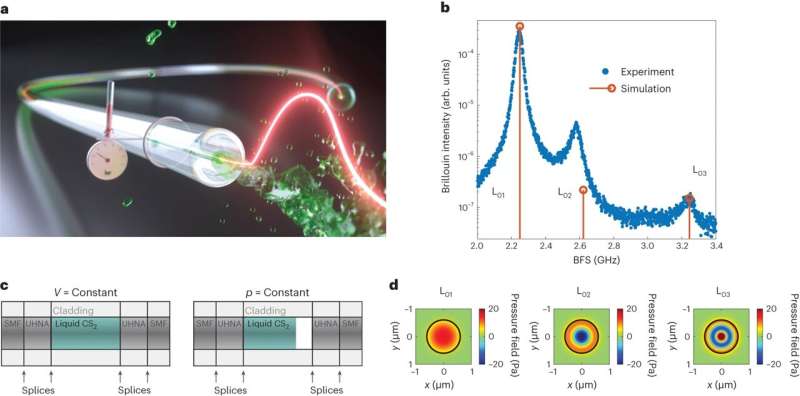
Negative pressure is a rare and difficult to detect phenomenon in physics. Using liquid-filled optical fibers and sound waves, researchers at the Max Planck Institute for Light Science (MPL) in Erlangen have now discovered a new method to measure this. In collaboration with the Leibniz Institute for Photonic Technologies (IPHT) in Jena, researchers from the quantum optoacoustics research group led by Birgit Stiller can gain important insights into thermodynamic states.
As a physical quantity, pressure is encountered in various fields: atmospheric pressure in meteorology, blood pressure in medicine or even in everyday life with pressure cookers and vacuum food. Pressure is defined as the force per unit area acting perpendicular to the surface of a solid, liquid, or gas. Depending on the direction in which the force acts in a closed system, very high pressures in extreme cases can cause explosive reactions, while very low pressures in a closed system can cause the system itself to collapse.
Overpressure always means that a gas or liquid pushes against the walls of that container from the inside, like a balloon that expands when air is added. Regardless of whether it is high or low pressure, the numerical value of pressure is normally always positive.
However, liquids have a peculiar property. They can exist in a specific metastable state corresponding to the value of negative pressure. In this metastable state, even a small external influence can cause the system to collapse into one state or the other. You can imagine sitting on top of a roller coaster: the slightest touch on one side or the other sends you hurtling down the rails. In current research, the researchers are investigating the metastable state of liquids under negative pressure.
To achieve this, the research team combined two unique techniques in a study published in Natural physics to measure different thermodynamic states. Initially, small nanoliter amounts of liquid were encapsulated in a fully sealed optical fiber, allowing for both very positive and negative pressures. Then, the specific interaction of optical and acoustic waves in the liquid made it possible to sensitively measure the effect of pressure and temperature in different states of the liquid.
Sound waves act as sensors to probe negative pressure values, probing this unique state of matter with high precision and detailed spatial resolution.
The effect of negative pressure on a liquid can be imagined as follows: According to the laws of thermodynamics, the volume of the liquid decreases, but the liquid remains trapped in the glass fiber capillary by adhesive forces, similar to a drop of water that sticks to. finger. This results in “stretching” of the liquid. It is unstretched and behaves like a stretched rubber band.
Measuring this exotic state usually requires sophisticated equipment with heightened safety measures. High pressure can be a dangerous business, especially with toxic liquids. Carbon disulfide, which the researchers used in this study, falls into this category. Because of this complication, previous measurement setups for generating and determining negative pressures have required significant laboratory space and even generated disturbances in the metastable state.
Using the method presented here, the researchers have instead developed a small and simple setup in which they can make very precise pressure measurements using light and sound waves. The fibers used for this purpose are as thick as human hair.
“Some phenomena that are difficult to study with conventional and established methods can suddenly become accessible when new measurement methods are combined with novel platforms. I find this exciting,” says Dr. Birgit Stiller, head of MPL’s quantum optoacoustics research group.
The sound waves used by the group can very sensitively detect changes in temperature, pressure and voltage along an optical fiber. In addition, spatially resolved measurements are possible, meaning that sound waves can provide a picture of the situation inside an optical fiber with centimeter-scale resolution along its entire length.
“Our method allows us to gain a deeper understanding of the thermodynamic dependencies of this unique fiber-based system,” says Alexandra Popp, one of the paper’s two lead authors. Another lead author, Andreas Geilen, adds: “The measurements showed surprising effects. The observation of the low-pressure regime becomes quite clear when looking at the frequency of the sound waves.”
Combining optoacoustic measurements with tightly packed capillary fibers enables new discoveries in monitoring chemical reactions in toxic liquids in otherwise difficult-to-probe materials and microreactors. It can penetrate new, hard-to-reach areas of thermodynamics.
“This new platform of fully closed liquid core fibers provides access to high pressures and other thermodynamic regimes,” says Prof. Markus Schmidt from the Jena IPHT, and Dr. Mario Chemnitz, also from the Jena IPHT, emphasizes: “This is excellent. It is of great interest to study and even adapt it additional nonlinear optical phenomena of type fibers.”
These phenomena can open up previously unexplored and potentially new properties in the unique thermodynamic state of materials. Birgit Stiller concludes: “The collaboration of our research groups in Erlangen and Jena with their respective expertise is unique to obtain new insights into thermodynamic processes and regimes on a small and easily handled optical platform.”
More information:
Geilen, A. et al., Extreme thermodynamics in nanoliter quantities via stimulated BrillouinMandelstam scattering, Natural physics (2023). DOI: 10.1038/s41567-023-02205-1. www.nature.com/articles/s41567-023-02205-1
Provided by the Max Planck Society
Quote: Light and sound waves reveal negative pressure (2023, September 25) Retrieved on September 26, 2023, from https://phys.org/news/2023-09-reveal-negative-pressure.html
This document is protected by copyright. Except for fair dealing for private study or research purposes, no part may be reproduced without written permission. Content is provided for informational purposes only.
#Light #sound #waves #negative #pressure
Image Source : phys.org